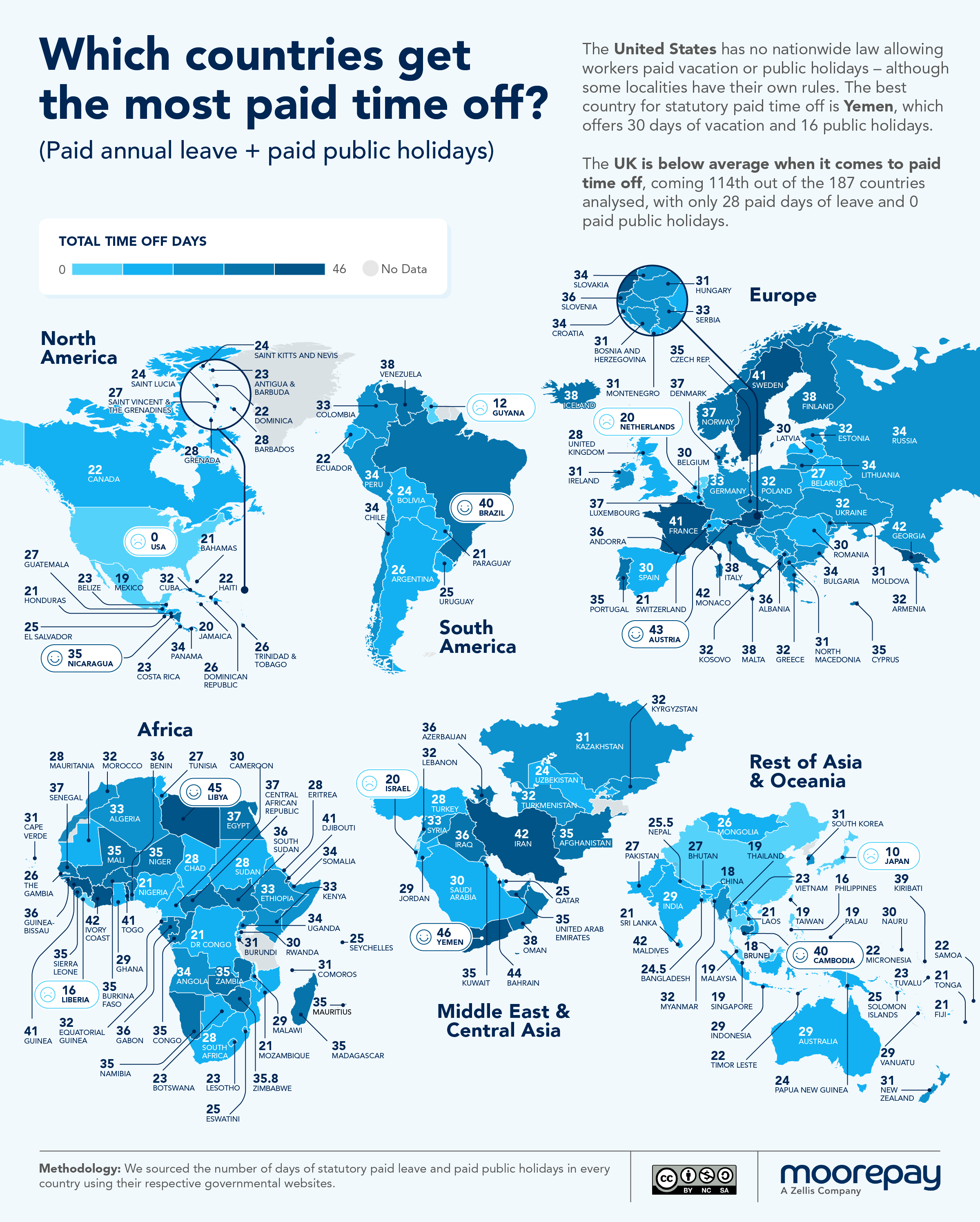Paid Vacation Time by Country Map


Alex Cartwright
Senior Cartographer & GIS Specialist
Alex Cartwright is a renowned cartographer and geographic information systems specialist with over 15 years of experience in spatial analysis and data...
Geographic Analysis
What This Map Shows
This map visualizes the varying amounts of paid vacation days offered to workers across different countries. It highlights stark contrasts in vacation policies, revealing how cultural attitudes towards work-life balance and labor regulations influence the number of paid days off employees receive. Understanding these differences offers insight into the broader societal values and economic conditions of nations around the world.
Deep Dive into Paid Vacation Policies
Paid vacation time is a crucial aspect of labor rights, reflecting a country's commitment to employee well-being and work-life balance. Interestingly, the amount of paid vacation varies significantly across the globe, shaped by historical, economic, and social factors. For instance, in many European countries, it's common for workers to receive four to six weeks of paid vacation annually. In contrast, the United States does not have a federally mandated minimum for paid vacation, leading to a situation where many American workers receive significantly less time off.
According to the International Labour Organization (ILO), countries like France, Germany, and Spain offer among the highest vacation allowances, with workers enjoying up to 30 days off per year. This generous allotment is rooted in a cultural emphasis on leisure and family time, which contrasts sharply with nations where work is prioritized over personal time. For example, in Japan, while workers are entitled to paid vacation, many do not take the full amount due to workplace culture that often discourages time off. This phenomenon, known as 'karoshi' or death from overwork, highlights the negative implications of inadequate vacation utilization.
In addition to cultural influences, economic conditions also play a significant role in shaping vacation policies. For instance, countries with stronger labor unions and progressive social policies typically enforce better vacation entitlements. Conversely, in nations where labor rights are less emphasized, employees may find themselves with minimal vacation days, if any at all. This disparity raises questions about the implications for worker productivity and mental health. Studies have shown that employees who take regular vacations are generally more productive and report higher levels of job satisfaction.
It's also worth noting that the trend of remote work, accelerated by the pandemic, has blurred the lines around vacation policies. As more employees work from home, the traditional boundaries of work and leisure have shifted, leading to discussions about how vacation time should be redefined in this new context. Are companies adapting their vacation policies to fit the remote work model? This is a question many are asking as they evaluate the future of work-life balance.
Regional Analysis
When we break down the data by region, the differences in paid vacation policies become even more pronounced. In Europe, most countries abide by the European Union's directive that mandates at least four weeks of paid vacation for employees. For example, Scandinavian countries like Sweden and Denmark take vacation seriously, offering between five to six weeks of paid time off. This reflects their strong emphasis on worker rights and well-being.
In contrast, the situation in North America is quite different. The United States, as mentioned earlier, does not have a statutory minimum for vacation days. According to a 2021 report by the Bureau of Labor Statistics, private sector employees averaged about 10 days of paid vacation after one year of service. Canada is slightly better, with a minimum standard of two weeks, but still lags behind many other developed nations.
In Asia, the scenario varies widely. Countries like South Korea and China have laws mandating a minimum number of paid vacation days, but cultural practices often prevent employees from taking full advantage of them. On the other hand, countries such as the Philippines provide a more generous vacation policy, reflecting a different cultural attitude towards work-life balance. The Middle East presents another intriguing picture where vacation policies are often dictated by local customs and the expatriate workforce's needs.
Significance and Impact
Understanding how paid vacation varies around the world is crucial for multiple reasons. First, it sheds light on the importance of worker rights and the value placed on employee well-being across cultures. Countries that prioritize vacation time typically see positive outcomes in productivity, employee satisfaction, and overall mental health.
Moreover, as globalization continues to influence labor markets, companies operating internationally must navigate these differences in vacation policies. For example, multinational corporations must adapt their human resource strategies to align with local expectations regarding work-life balance, especially as they seek to attract and retain talent in various regions.
As we move forward, it’s essential to monitor trends in paid vacation policies globally. The pandemic has already reshaped many work cultures, and the potential for change in vacation policies could lead to more equitable treatment of workers worldwide. Will we see an increase in the number of paid vacation days as companies recognize the importance of employee well-being? Only time will tell, but the conversation around vacation rights is certainly evolving.
In conclusion, the map of paid vacation time around the world not only illustrates stark contrasts but also invites us to reflect on what these disparities mean for workers everywhere. As we advocate for better labor policies, understanding these dynamics becomes increasingly vital.
Visualization Details
- Published
- August 12, 2025
- Views
- 174
Comments
Loading comments...